Financial Performance Analysis: Applied Business Finance Report
VerifiedAdded on 2022/12/23
|13
|2716
|81
Report
AI Summary
This report delves into the core concepts of financial management, emphasizing its crucial role in strategic planning, organization, and control of financial undertakings within a firm. It explores the significance of financial management in ensuring the effective use of management principles for bette...

Applied Business
Finance
Finance
Paraphrase This Document
Need a fresh take? Get an instant paraphrase of this document with our AI Paraphraser

Table of Contents
INTRODUCTION...........................................................................................................................1
Section 1...........................................................................................................................................1
Concept and importance of financial management................................................................1
Section 2...........................................................................................................................................2
Main financial statement........................................................................................................2
Use of ratios in financial management...................................................................................3
Section 3:.........................................................................................................................................4
The profitability, liquidity and efficiency of the company based on the results of ratio analysis
................................................................................................................................................4
Section 4:.........................................................................................................................................4
The process can be adopted by company to improve their financial performance................4
CONCLUSION................................................................................................................................6
REFERENCES................................................................................................................................6
APPENDIX......................................................................................................................................8
INTRODUCTION...........................................................................................................................1
Section 1...........................................................................................................................................1
Concept and importance of financial management................................................................1
Section 2...........................................................................................................................................2
Main financial statement........................................................................................................2
Use of ratios in financial management...................................................................................3
Section 3:.........................................................................................................................................4
The profitability, liquidity and efficiency of the company based on the results of ratio analysis
................................................................................................................................................4
Section 4:.........................................................................................................................................4
The process can be adopted by company to improve their financial performance................4
CONCLUSION................................................................................................................................6
REFERENCES................................................................................................................................6
APPENDIX......................................................................................................................................8
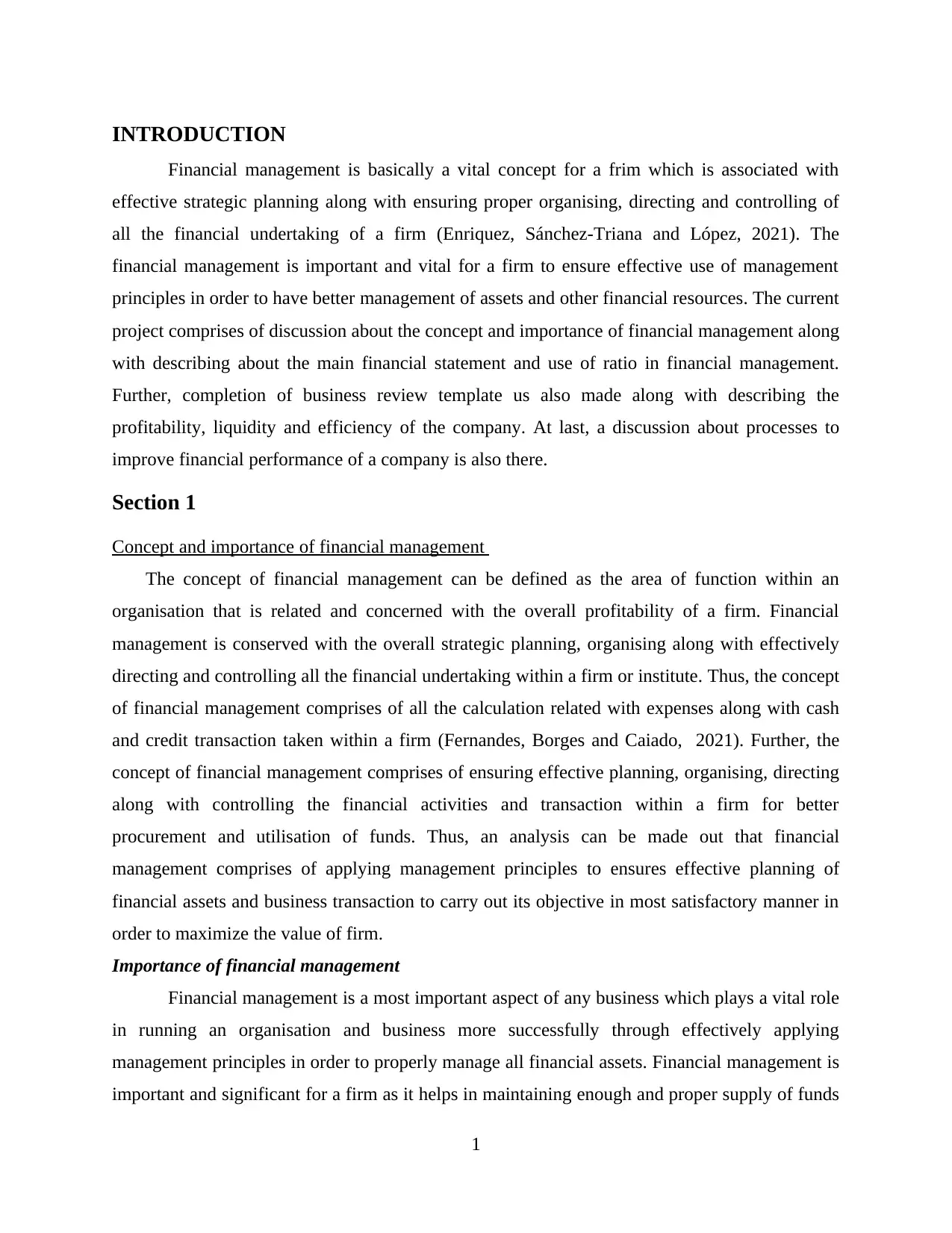
INTRODUCTION
Financial management is basically a vital concept for a frim which is associated with
effective strategic planning along with ensuring proper organising, directing and controlling of
all the financial undertaking of a firm (Enriquez, Sánchez-Triana and López, 2021). The
financial management is important and vital for a firm to ensure effective use of management
principles in order to have better management of assets and other financial resources. The current
project comprises of discussion about the concept and importance of financial management along
with describing about the main financial statement and use of ratio in financial management.
Further, completion of business review template us also made along with describing the
profitability, liquidity and efficiency of the company. At last, a discussion about processes to
improve financial performance of a company is also there.
Section 1
Concept and importance of financial management
The concept of financial management can be defined as the area of function within an
organisation that is related and concerned with the overall profitability of a firm. Financial
management is conserved with the overall strategic planning, organising along with effectively
directing and controlling all the financial undertaking within a firm or institute. Thus, the concept
of financial management comprises of all the calculation related with expenses along with cash
and credit transaction taken within a firm (Fernandes, Borges and Caiado, 2021). Further, the
concept of financial management comprises of ensuring effective planning, organising, directing
along with controlling the financial activities and transaction within a firm for better
procurement and utilisation of funds. Thus, an analysis can be made out that financial
management comprises of applying management principles to ensures effective planning of
financial assets and business transaction to carry out its objective in most satisfactory manner in
order to maximize the value of firm.
Importance of financial management
Financial management is a most important aspect of any business which plays a vital role
in running an organisation and business more successfully through effectively applying
management principles in order to properly manage all financial assets. Financial management is
important and significant for a firm as it helps in maintaining enough and proper supply of funds
1
Financial management is basically a vital concept for a frim which is associated with
effective strategic planning along with ensuring proper organising, directing and controlling of
all the financial undertaking of a firm (Enriquez, Sánchez-Triana and López, 2021). The
financial management is important and vital for a firm to ensure effective use of management
principles in order to have better management of assets and other financial resources. The current
project comprises of discussion about the concept and importance of financial management along
with describing about the main financial statement and use of ratio in financial management.
Further, completion of business review template us also made along with describing the
profitability, liquidity and efficiency of the company. At last, a discussion about processes to
improve financial performance of a company is also there.
Section 1
Concept and importance of financial management
The concept of financial management can be defined as the area of function within an
organisation that is related and concerned with the overall profitability of a firm. Financial
management is conserved with the overall strategic planning, organising along with effectively
directing and controlling all the financial undertaking within a firm or institute. Thus, the concept
of financial management comprises of all the calculation related with expenses along with cash
and credit transaction taken within a firm (Fernandes, Borges and Caiado, 2021). Further, the
concept of financial management comprises of ensuring effective planning, organising, directing
along with controlling the financial activities and transaction within a firm for better
procurement and utilisation of funds. Thus, an analysis can be made out that financial
management comprises of applying management principles to ensures effective planning of
financial assets and business transaction to carry out its objective in most satisfactory manner in
order to maximize the value of firm.
Importance of financial management
Financial management is a most important aspect of any business which plays a vital role
in running an organisation and business more successfully through effectively applying
management principles in order to properly manage all financial assets. Financial management is
important and significant for a firm as it helps in maintaining enough and proper supply of funds
1
⊘ This is a preview!⊘
Do you want full access?
Subscribe today to unlock all pages.

Trusted by 1+ million students worldwide

for a company along with ensuring improved return on investments by the way of efficient and
optimum utilisation of funds (Oware and Mallikarjunappa, 2021). Apart from this, financial
management is also important for creating and having real time safe investment opportunities
through leading improved planning and better organising of finance and other monetary funds.
Further, importance of financial management can be evaluated from various other aspects and
reasons which are listed as below:
Financial management helps an organisation in having effective financial planning with
support better asset and resource management along with improved acquisition of funds
(What is the importance of Financial Management?, 2018).
Apart from this, financial management helps a company to effective utilise and allocate
its funds along with supporting and assisting with more effective and critical financial
decision making to have improved profitability.
Financial management is also important to provide better economic stability through
increasing overall value and profitability of firm.
Section 2
Main financial statement
Financial statements mainly comprise of reports which are prepared by the management of
a company to present and reflect true financial performance and position of a firm at a given
specific point of time. The main financial statement which are prepared by a company within an
accounting year are described and discussed as below:
Balance Sheet- It is one of the most vital and important financial statement which reports
and provide information about the assets, liabilities and overall equality of shareholder of a
company at a specific point of time (Majerowska and Spigarska, 2021). Thus, preparation of
balance sheet is important to provide a summary of overall assets and liabilities of a form at a
particular moment that also reflects basis of computing rates and return to effectively evaluate
and present true financial position of a firm.
Income statement- It is a financial statement which provides information about the overall
profitable of a business for a given reporting period. Income statement is also known as profit
and loss statement which shows the revenue minus expenses and loses during a particular period
thus, provide information about gross and net profit of a firm.
2
optimum utilisation of funds (Oware and Mallikarjunappa, 2021). Apart from this, financial
management is also important for creating and having real time safe investment opportunities
through leading improved planning and better organising of finance and other monetary funds.
Further, importance of financial management can be evaluated from various other aspects and
reasons which are listed as below:
Financial management helps an organisation in having effective financial planning with
support better asset and resource management along with improved acquisition of funds
(What is the importance of Financial Management?, 2018).
Apart from this, financial management helps a company to effective utilise and allocate
its funds along with supporting and assisting with more effective and critical financial
decision making to have improved profitability.
Financial management is also important to provide better economic stability through
increasing overall value and profitability of firm.
Section 2
Main financial statement
Financial statements mainly comprise of reports which are prepared by the management of
a company to present and reflect true financial performance and position of a firm at a given
specific point of time. The main financial statement which are prepared by a company within an
accounting year are described and discussed as below:
Balance Sheet- It is one of the most vital and important financial statement which reports
and provide information about the assets, liabilities and overall equality of shareholder of a
company at a specific point of time (Majerowska and Spigarska, 2021). Thus, preparation of
balance sheet is important to provide a summary of overall assets and liabilities of a form at a
particular moment that also reflects basis of computing rates and return to effectively evaluate
and present true financial position of a firm.
Income statement- It is a financial statement which provides information about the overall
profitable of a business for a given reporting period. Income statement is also known as profit
and loss statement which shows the revenue minus expenses and loses during a particular period
thus, provide information about gross and net profit of a firm.
2
Paraphrase This Document
Need a fresh take? Get an instant paraphrase of this document with our AI Paraphraser

Cash Flow statement- It is another vital financial statement which provides a
summarisation about the flow of cash during a specific period of time through reflecting
transaction about the amount of cash and cash equivalents which is entering and leaving a
company. Thus, cash flow management is important for a firm to manage its cash position
through keeping a check on its flow along with analysing that how well a company is generating
cash to meet its debt obligation to ensure effective fund generation to regular pay its operating
expenses.
Statement of shareholder’s equity or retained earnings- It is basically a financial
document which is issued by a company as a part of its balance sheet which basically highlights
the value of stockholders and equity of shareholders along with reflecting about the ownership
interest of the company (Kabir, 2021). The main objective of stakeholders’ statement is to
provide information about equity along with the retained earning of a company along with
additional equity capital which could be reinvested into company.
Use of ratios in financial management
Use of various key financial ratio like return on assets, return on investment, current ratio,
quick ratio, profit margin ratio, etc. are made which ensures and provides better comparison of
financial performance along with depicting true position of finance within a firm. Thus, use of
financial ratio is important and vital within the financial statement to ensure better analysis of
trends line along with leading operational efficiency through improved calculation and
comparison about company’s position (Feil, Feijo and Horn, 2021).
Return to asset ratio (ROA)- The return to asset ratio basically present the percentage of
how profitable the asset of company is in generating revenue. The formula to calculate return to
asset is provided as below:
Return to asset = Net income / average of total asset.
Use of return to asset ratios provides a better indication about the capital intensity of the
company which mainly depends on the company’s large initial investment.
Return to investment- It basically present the information about the ratio between net
income and investment which is calculated by subtracting the initial value of the investment from
the final value of the investment (which equals the net return), then dividing this new number
(the net return) by the cost of the investment, and, finally, multiplying it by 100.
3
summarisation about the flow of cash during a specific period of time through reflecting
transaction about the amount of cash and cash equivalents which is entering and leaving a
company. Thus, cash flow management is important for a firm to manage its cash position
through keeping a check on its flow along with analysing that how well a company is generating
cash to meet its debt obligation to ensure effective fund generation to regular pay its operating
expenses.
Statement of shareholder’s equity or retained earnings- It is basically a financial
document which is issued by a company as a part of its balance sheet which basically highlights
the value of stockholders and equity of shareholders along with reflecting about the ownership
interest of the company (Kabir, 2021). The main objective of stakeholders’ statement is to
provide information about equity along with the retained earning of a company along with
additional equity capital which could be reinvested into company.
Use of ratios in financial management
Use of various key financial ratio like return on assets, return on investment, current ratio,
quick ratio, profit margin ratio, etc. are made which ensures and provides better comparison of
financial performance along with depicting true position of finance within a firm. Thus, use of
financial ratio is important and vital within the financial statement to ensure better analysis of
trends line along with leading operational efficiency through improved calculation and
comparison about company’s position (Feil, Feijo and Horn, 2021).
Return to asset ratio (ROA)- The return to asset ratio basically present the percentage of
how profitable the asset of company is in generating revenue. The formula to calculate return to
asset is provided as below:
Return to asset = Net income / average of total asset.
Use of return to asset ratios provides a better indication about the capital intensity of the
company which mainly depends on the company’s large initial investment.
Return to investment- It basically present the information about the ratio between net
income and investment which is calculated by subtracting the initial value of the investment from
the final value of the investment (which equals the net return), then dividing this new number
(the net return) by the cost of the investment, and, finally, multiplying it by 100.
3
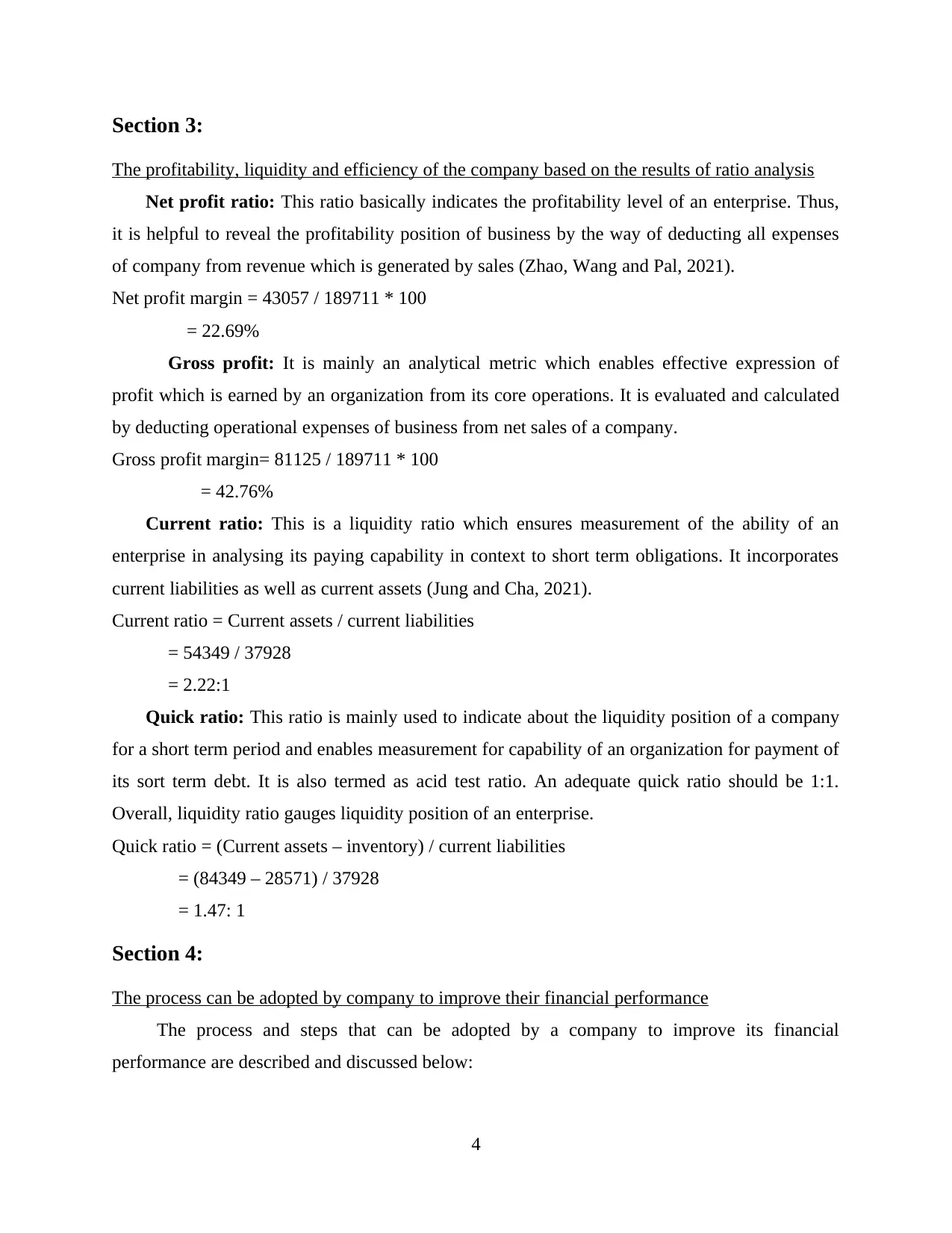
Section 3:
The profitability, liquidity and efficiency of the company based on the results of ratio analysis
Net profit ratio: This ratio basically indicates the profitability level of an enterprise. Thus,
it is helpful to reveal the profitability position of business by the way of deducting all expenses
of company from revenue which is generated by sales (Zhao, Wang and Pal, 2021).
Net profit margin = 43057 / 189711 * 100
= 22.69%
Gross profit: It is mainly an analytical metric which enables effective expression of
profit which is earned by an organization from its core operations. It is evaluated and calculated
by deducting operational expenses of business from net sales of a company.
Gross profit margin= 81125 / 189711 * 100
= 42.76%
Current ratio: This is a liquidity ratio which ensures measurement of the ability of an
enterprise in analysing its paying capability in context to short term obligations. It incorporates
current liabilities as well as current assets (Jung and Cha, 2021).
Current ratio = Current assets / current liabilities
= 54349 / 37928
= 2.22:1
Quick ratio: This ratio is mainly used to indicate about the liquidity position of a company
for a short term period and enables measurement for capability of an organization for payment of
its sort term debt. It is also termed as acid test ratio. An adequate quick ratio should be 1:1.
Overall, liquidity ratio gauges liquidity position of an enterprise.
Quick ratio = (Current assets – inventory) / current liabilities
= (84349 – 28571) / 37928
= 1.47: 1
Section 4:
The process can be adopted by company to improve their financial performance
The process and steps that can be adopted by a company to improve its financial
performance are described and discussed below:
4
The profitability, liquidity and efficiency of the company based on the results of ratio analysis
Net profit ratio: This ratio basically indicates the profitability level of an enterprise. Thus,
it is helpful to reveal the profitability position of business by the way of deducting all expenses
of company from revenue which is generated by sales (Zhao, Wang and Pal, 2021).
Net profit margin = 43057 / 189711 * 100
= 22.69%
Gross profit: It is mainly an analytical metric which enables effective expression of
profit which is earned by an organization from its core operations. It is evaluated and calculated
by deducting operational expenses of business from net sales of a company.
Gross profit margin= 81125 / 189711 * 100
= 42.76%
Current ratio: This is a liquidity ratio which ensures measurement of the ability of an
enterprise in analysing its paying capability in context to short term obligations. It incorporates
current liabilities as well as current assets (Jung and Cha, 2021).
Current ratio = Current assets / current liabilities
= 54349 / 37928
= 2.22:1
Quick ratio: This ratio is mainly used to indicate about the liquidity position of a company
for a short term period and enables measurement for capability of an organization for payment of
its sort term debt. It is also termed as acid test ratio. An adequate quick ratio should be 1:1.
Overall, liquidity ratio gauges liquidity position of an enterprise.
Quick ratio = (Current assets – inventory) / current liabilities
= (84349 – 28571) / 37928
= 1.47: 1
Section 4:
The process can be adopted by company to improve their financial performance
The process and steps that can be adopted by a company to improve its financial
performance are described and discussed below:
4
⊘ This is a preview!⊘
Do you want full access?
Subscribe today to unlock all pages.

Trusted by 1+ million students worldwide

Have a clear business plan- Having a clear business plan would lead and ensure a more
effective financial management through leading out better panning, organising and controlling of
company’s assets. Further, a well defend business goals and future plans would ensure more
clarity about the requirement of funds and other business activities and financial transaction
which would support and lead out an improved financial management for a form to support
improved financial performance (Du, Liu and Lu, 2021).
Monitoring Financial position- It also suggested for accompany to have effective
monitoring step within its financial management process to set an improved control and check on
flow of its monetary funds along with analysing the uses. Implication of an effective process by a
company would ensure and lead out to more optimise and efficient uses of financial resources
through reducing the amount of wastage and other financial expense in order to have improved
financial performance (Oware and Mallikarjunappa, 2021). Keeping a check on financial
position ensures improved backup and help to maintain adequate money stock in order to
maintain a stable and efficient financial performance in order to conduct day to day activity in
more efficient manner.
Ensure regular payment from customers- The another vital process to have an improved
financial performance comprises of ensuring regular and significant payment from customers as
majority of financial problem faced by a company is due to late customer payment. Thus, some
improved strategies like providing various option of payment, discounts, etc. could also be
offered by the company to ensure regular payment from customers. beside this, having regular
and adequate payment from customers also reduce the risk of company overhead and issues
related with non-payment thus, having an efficient and computerised credit management system
should be introduced in company process to ensures and have improved financial performance
(Majerowska and Spigarska, 2021).
Updating accounting records and knowing data to day cost- The another improved
process to have better financial performance comprises of regular updating accounting process as
it ensures reflection of true and accurate financial position so that more effective discussion can
be taken on the basis of update information. Beside this, having knowledge about day to day
operation cost and other expenses also offer and ensure an improved level of financial planning
to have better financial performance.
5
effective financial management through leading out better panning, organising and controlling of
company’s assets. Further, a well defend business goals and future plans would ensure more
clarity about the requirement of funds and other business activities and financial transaction
which would support and lead out an improved financial management for a form to support
improved financial performance (Du, Liu and Lu, 2021).
Monitoring Financial position- It also suggested for accompany to have effective
monitoring step within its financial management process to set an improved control and check on
flow of its monetary funds along with analysing the uses. Implication of an effective process by a
company would ensure and lead out to more optimise and efficient uses of financial resources
through reducing the amount of wastage and other financial expense in order to have improved
financial performance (Oware and Mallikarjunappa, 2021). Keeping a check on financial
position ensures improved backup and help to maintain adequate money stock in order to
maintain a stable and efficient financial performance in order to conduct day to day activity in
more efficient manner.
Ensure regular payment from customers- The another vital process to have an improved
financial performance comprises of ensuring regular and significant payment from customers as
majority of financial problem faced by a company is due to late customer payment. Thus, some
improved strategies like providing various option of payment, discounts, etc. could also be
offered by the company to ensure regular payment from customers. beside this, having regular
and adequate payment from customers also reduce the risk of company overhead and issues
related with non-payment thus, having an efficient and computerised credit management system
should be introduced in company process to ensures and have improved financial performance
(Majerowska and Spigarska, 2021).
Updating accounting records and knowing data to day cost- The another improved
process to have better financial performance comprises of regular updating accounting process as
it ensures reflection of true and accurate financial position so that more effective discussion can
be taken on the basis of update information. Beside this, having knowledge about day to day
operation cost and other expenses also offer and ensure an improved level of financial planning
to have better financial performance.
5
Paraphrase This Document
Need a fresh take? Get an instant paraphrase of this document with our AI Paraphraser
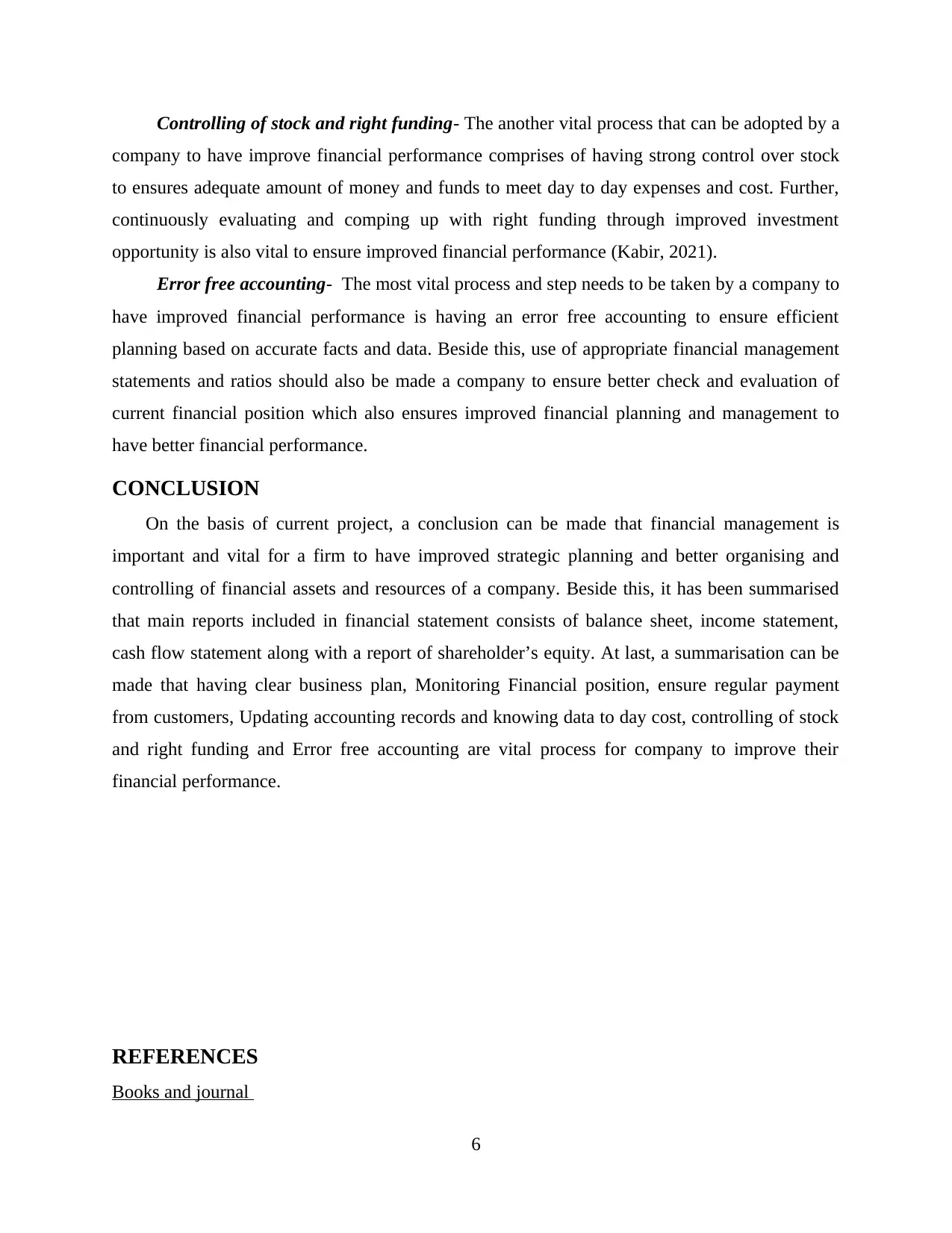
Controlling of stock and right funding- The another vital process that can be adopted by a
company to have improve financial performance comprises of having strong control over stock
to ensures adequate amount of money and funds to meet day to day expenses and cost. Further,
continuously evaluating and comping up with right funding through improved investment
opportunity is also vital to ensure improved financial performance (Kabir, 2021).
Error free accounting- The most vital process and step needs to be taken by a company to
have improved financial performance is having an error free accounting to ensure efficient
planning based on accurate facts and data. Beside this, use of appropriate financial management
statements and ratios should also be made a company to ensure better check and evaluation of
current financial position which also ensures improved financial planning and management to
have better financial performance.
CONCLUSION
On the basis of current project, a conclusion can be made that financial management is
important and vital for a firm to have improved strategic planning and better organising and
controlling of financial assets and resources of a company. Beside this, it has been summarised
that main reports included in financial statement consists of balance sheet, income statement,
cash flow statement along with a report of shareholder’s equity. At last, a summarisation can be
made that having clear business plan, Monitoring Financial position, ensure regular payment
from customers, Updating accounting records and knowing data to day cost, controlling of stock
and right funding and Error free accounting are vital process for company to improve their
financial performance.
REFERENCES
Books and journal
6
company to have improve financial performance comprises of having strong control over stock
to ensures adequate amount of money and funds to meet day to day expenses and cost. Further,
continuously evaluating and comping up with right funding through improved investment
opportunity is also vital to ensure improved financial performance (Kabir, 2021).
Error free accounting- The most vital process and step needs to be taken by a company to
have improved financial performance is having an error free accounting to ensure efficient
planning based on accurate facts and data. Beside this, use of appropriate financial management
statements and ratios should also be made a company to ensure better check and evaluation of
current financial position which also ensures improved financial planning and management to
have better financial performance.
CONCLUSION
On the basis of current project, a conclusion can be made that financial management is
important and vital for a firm to have improved strategic planning and better organising and
controlling of financial assets and resources of a company. Beside this, it has been summarised
that main reports included in financial statement consists of balance sheet, income statement,
cash flow statement along with a report of shareholder’s equity. At last, a summarisation can be
made that having clear business plan, Monitoring Financial position, ensure regular payment
from customers, Updating accounting records and knowing data to day cost, controlling of stock
and right funding and Error free accounting are vital process for company to improve their
financial performance.
REFERENCES
Books and journal
6

Du, G., Liu, Z. and Lu, H., 2021. Application of innovative risk early warning mode under big
data technology in Internet credit financial risk assessment. Journal of Computational
and Applied Mathematics, 386, p.113260.
Enriquez, S., Sánchez-Triana, E. and López, M.G.G., 2021. Economic Instruments and Financial
Mechanisms for the Adoption of a Circular Economy. In An Introduction to Circular
Economy (pp. 455-482). Springer, Singapore.
Feil, F., Feijo, C. and Horn, C.H., 2021. Regional credit distribution in Brazil: the role of state-
owned financial institutions. Area Development and Policy, pp.1-17.
Fernandes, C., Borges, M.R. and Caiado, J., 2021. The contribution of digital financial services
to financial inclusion in Mozambique: an ARDL model approach. Applied
Economics, 53(3), pp.400-409.
Jung, S.M. and Cha, H.E., 2021. Financial development and income inequality: evidence from
China. Journal of the Asia Pacific Economy, 26(1), pp.73-95.
Kabir, M.H., 2021. Financial Innovation: Accelerating Financial Inclusion in South Asia.
In Fostering Innovation and Competitiveness With FinTech, RegTech, and SupTech (pp.
186-209). IGI Global.
Majerowska, E. and Spigarska, E., 2021. Influence of Selected Internal Factors on the Outputs of
the Financial-Sector Companies Traded on the Warsaw Stock Exchange. In Eurasian
Economic Perspectives (pp. 193-204). Springer, Cham.
Oware, K.M. and Mallikarjunappa, T., 2021. Financial performance and gender diversity. The
effect of family management after a decade attempt. Society and Business Review.
Zhao, X., Wang, P. and Pal, R., 2021. The effects of agro-food supply chain integration on
product quality and financial performance: Evidence from Chinese agro-food processing
business. International Journal of Production Economics, 231, p.107832.
Online:
What is the importance of Financial Management?. 2018. [Online] Available Through:<
https://www.lsbf.org.uk/blog/news/importance-of-financial-management/117410 >.
7
data technology in Internet credit financial risk assessment. Journal of Computational
and Applied Mathematics, 386, p.113260.
Enriquez, S., Sánchez-Triana, E. and López, M.G.G., 2021. Economic Instruments and Financial
Mechanisms for the Adoption of a Circular Economy. In An Introduction to Circular
Economy (pp. 455-482). Springer, Singapore.
Feil, F., Feijo, C. and Horn, C.H., 2021. Regional credit distribution in Brazil: the role of state-
owned financial institutions. Area Development and Policy, pp.1-17.
Fernandes, C., Borges, M.R. and Caiado, J., 2021. The contribution of digital financial services
to financial inclusion in Mozambique: an ARDL model approach. Applied
Economics, 53(3), pp.400-409.
Jung, S.M. and Cha, H.E., 2021. Financial development and income inequality: evidence from
China. Journal of the Asia Pacific Economy, 26(1), pp.73-95.
Kabir, M.H., 2021. Financial Innovation: Accelerating Financial Inclusion in South Asia.
In Fostering Innovation and Competitiveness With FinTech, RegTech, and SupTech (pp.
186-209). IGI Global.
Majerowska, E. and Spigarska, E., 2021. Influence of Selected Internal Factors on the Outputs of
the Financial-Sector Companies Traded on the Warsaw Stock Exchange. In Eurasian
Economic Perspectives (pp. 193-204). Springer, Cham.
Oware, K.M. and Mallikarjunappa, T., 2021. Financial performance and gender diversity. The
effect of family management after a decade attempt. Society and Business Review.
Zhao, X., Wang, P. and Pal, R., 2021. The effects of agro-food supply chain integration on
product quality and financial performance: Evidence from Chinese agro-food processing
business. International Journal of Production Economics, 231, p.107832.
Online:
What is the importance of Financial Management?. 2018. [Online] Available Through:<
https://www.lsbf.org.uk/blog/news/importance-of-financial-management/117410 >.
7
⊘ This is a preview!⊘
Do you want full access?
Subscribe today to unlock all pages.

Trusted by 1+ million students worldwide
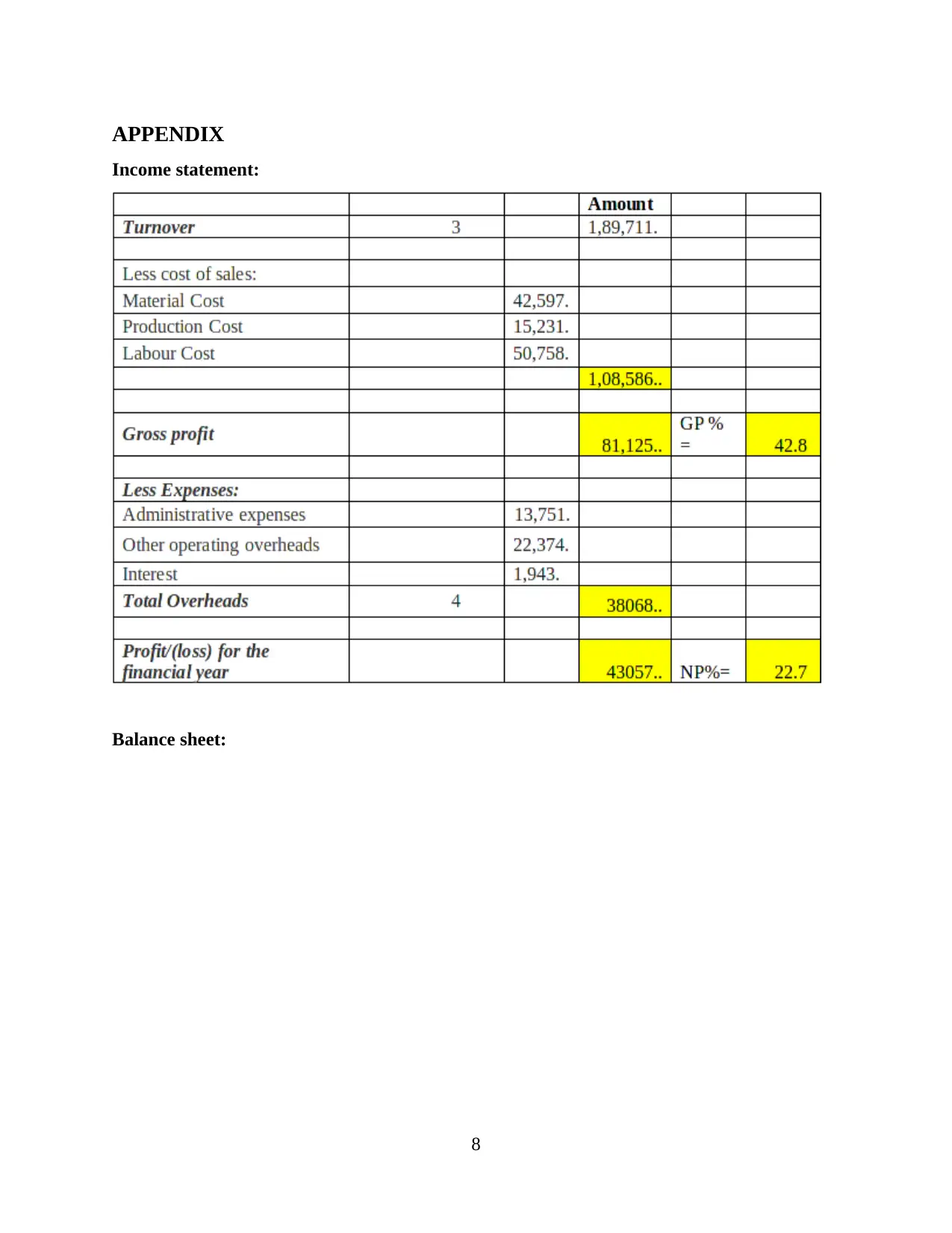
APPENDIX
Income statement:
Balance sheet:
8
Income statement:
Balance sheet:
8
Paraphrase This Document
Need a fresh take? Get an instant paraphrase of this document with our AI Paraphraser
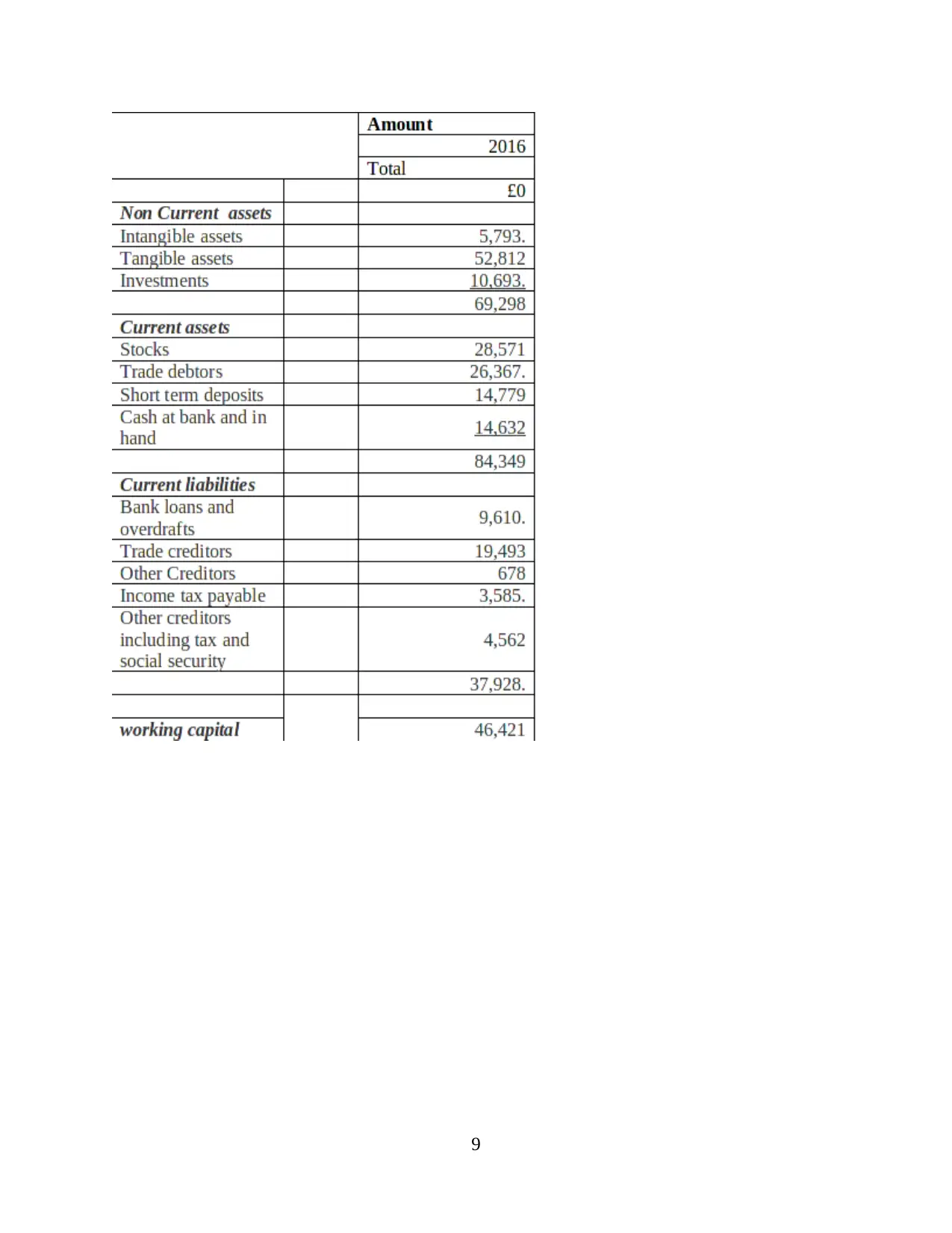
9
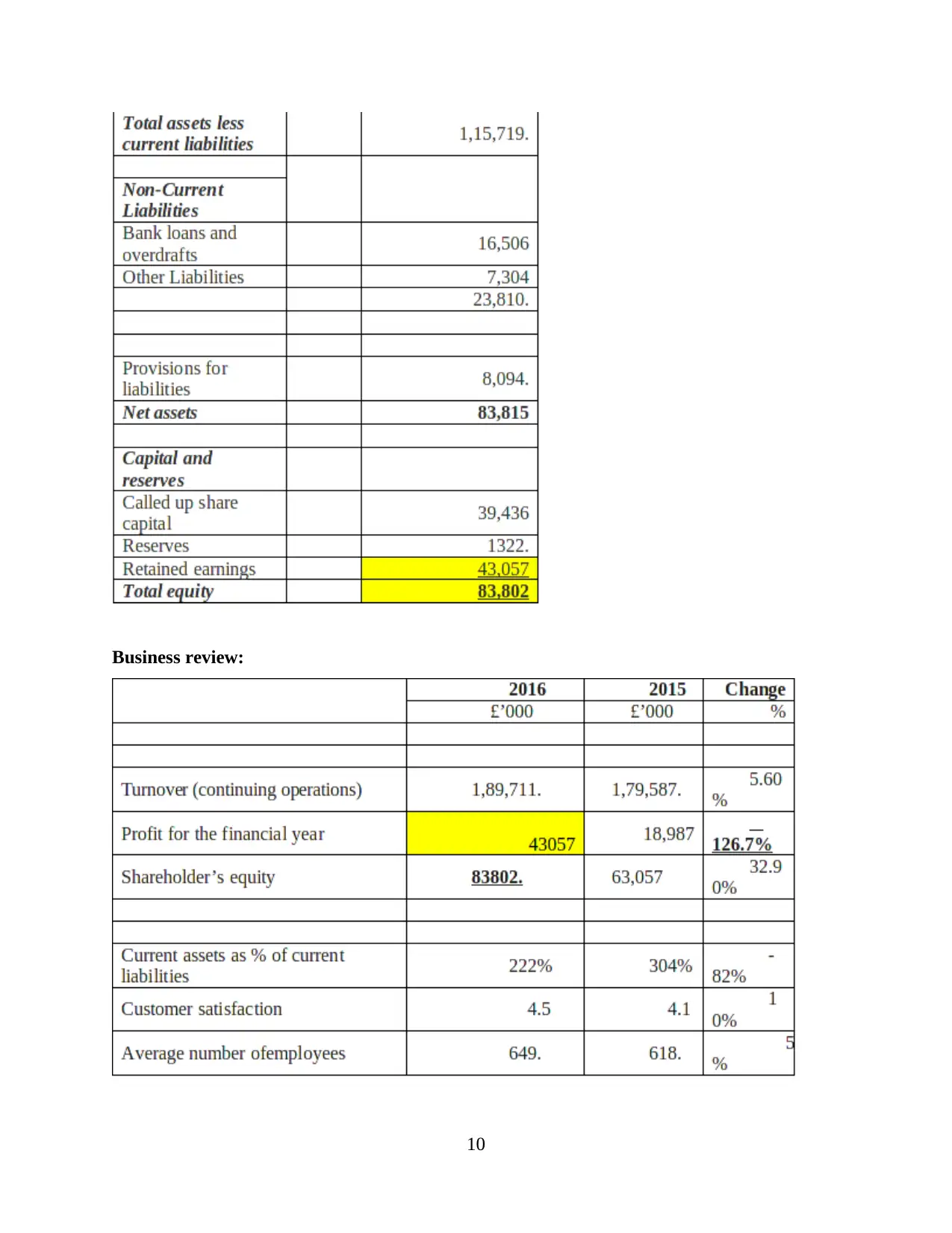
Business review:
10
10
⊘ This is a preview!⊘
Do you want full access?
Subscribe today to unlock all pages.

Trusted by 1+ million students worldwide
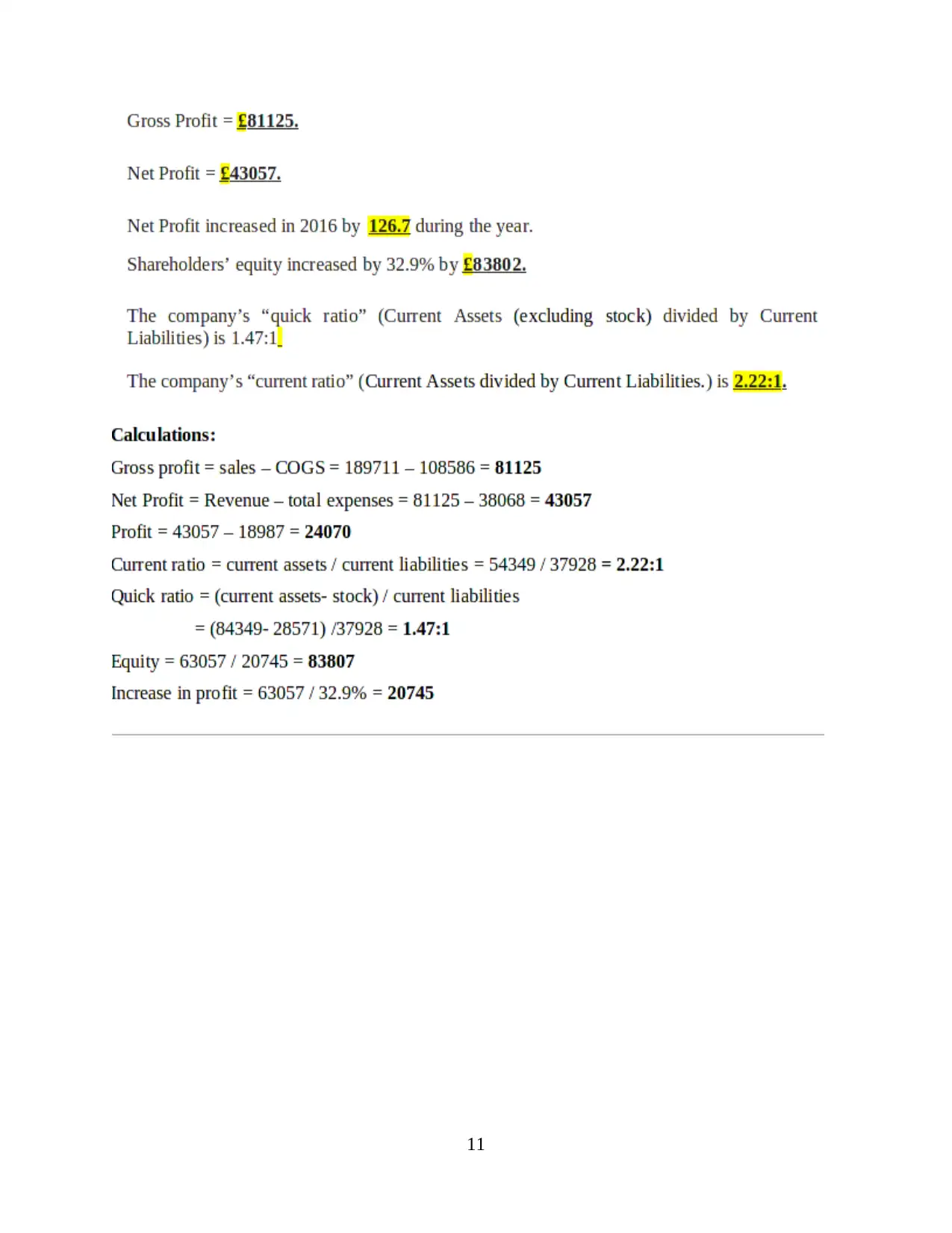
11
1 out of 13
Related Documents
Your All-in-One AI-Powered Toolkit for Academic Success.
+13062052269
info@desklib.com
Available 24*7 on WhatsApp / Email
![[object Object]](/_next/static/media/star-bottom.7253800d.svg)
Unlock your academic potential
© 2024 | Zucol Services PVT LTD | All rights reserved.



